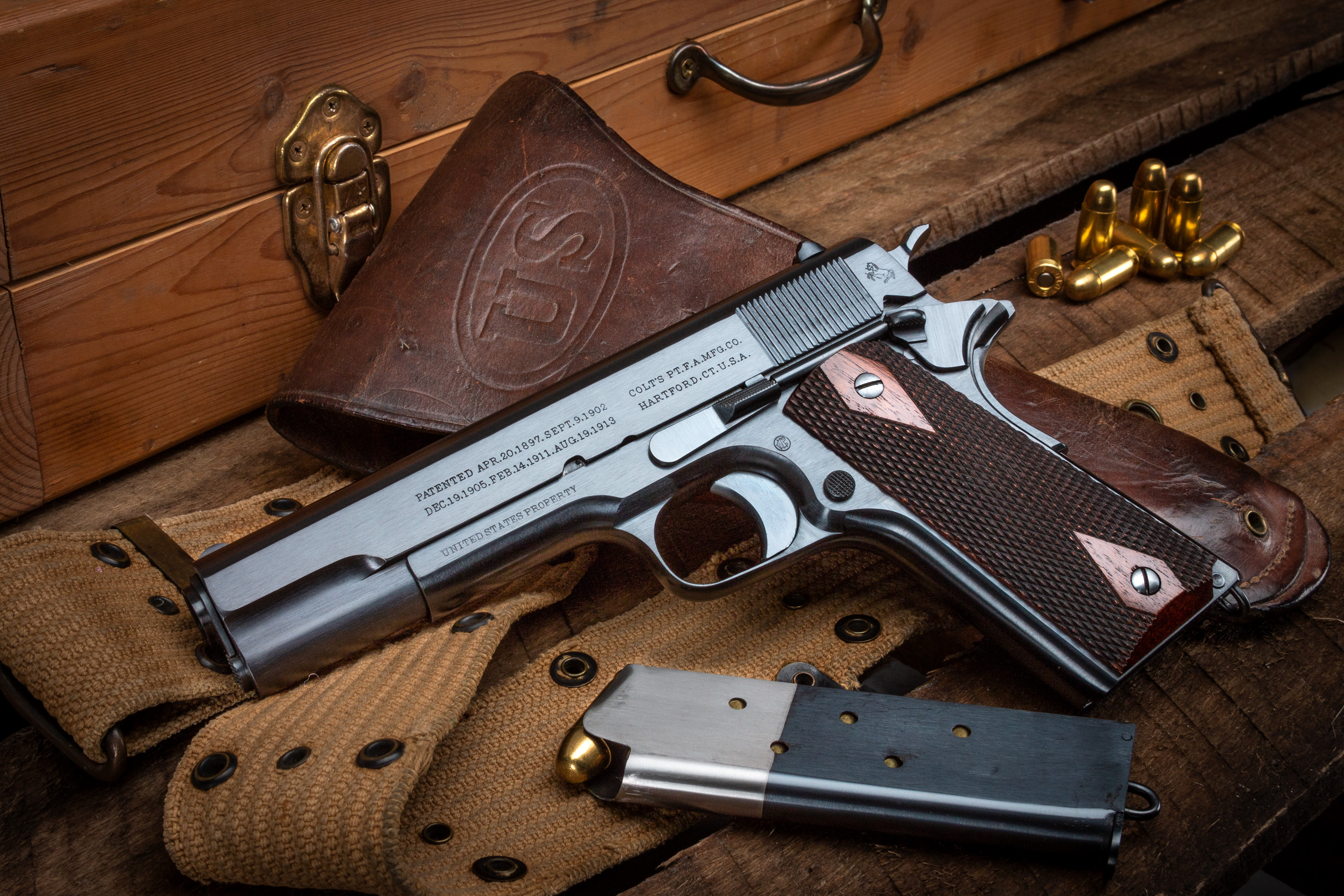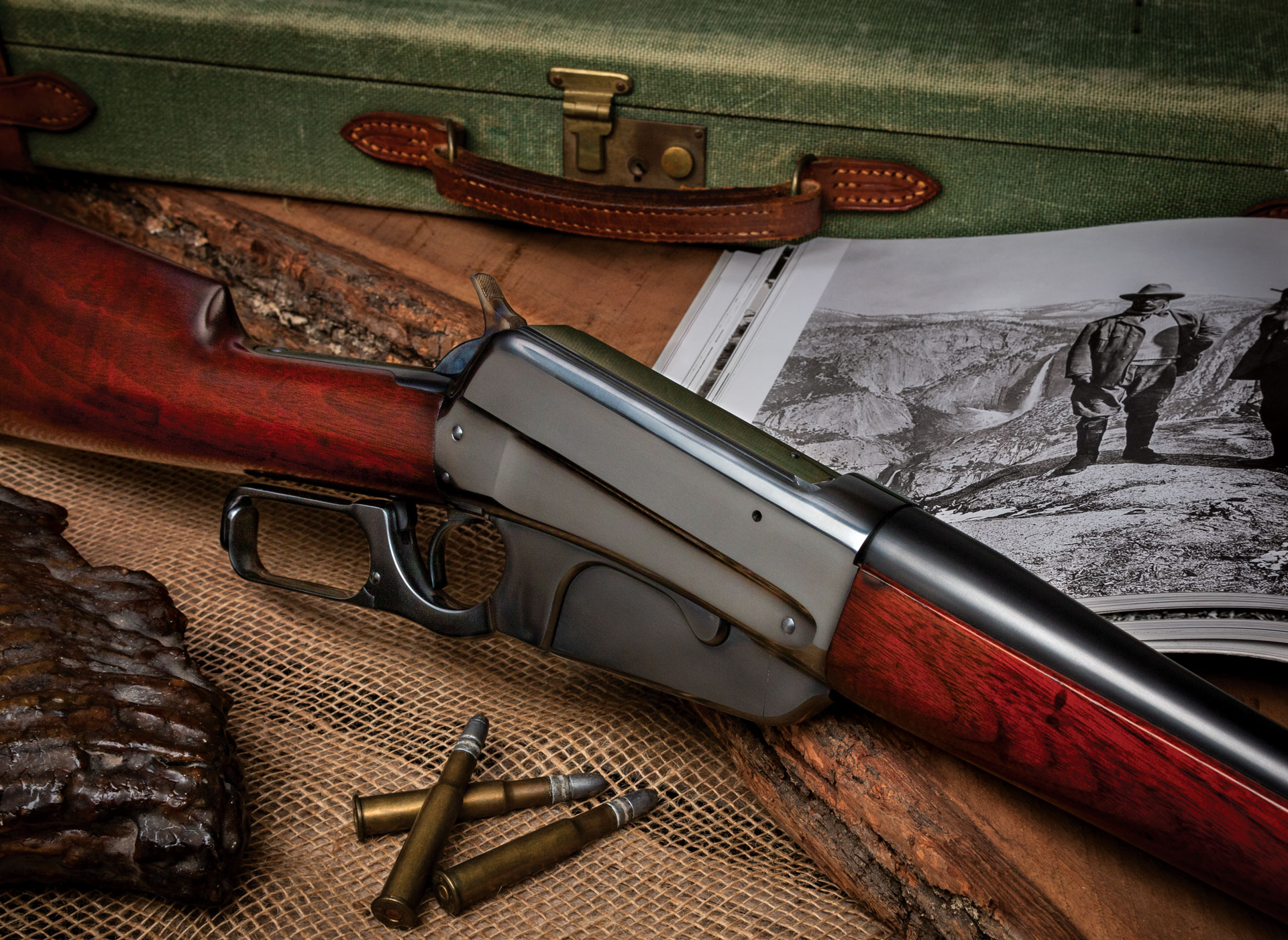Image: Restored Colt Model 1911 U.S. Army featuring year 1914-spec polish and charcoal blue finish.
The Art and Alchemy of Charcoal Bluing: A Look Back at an Antique Firearms Finish
Ah, charcoal bluing—one of the most iconic finishes to ever grace a firearm. If you’ve ever held a rifle or revolver from the late 1800s to early 1900s, there’s a good chance you’ve seen this old-world technique. Charcoal bluing was used to bring out a deep, lustrous finish that not only looked sharp but also helped protect steel from the elements. For serious collectors, a well-preserved charcoal-blued gun is like finding a rare gem in a field of gravel.
In this article, we’ll dig into the origins of charcoal bluing, why it was such a prized technique, and how it changed over time as firearms manufacturers moved into the modern era.
Today’s article continues our four-part series where we’ll do a historical deep dive into each of the old-world metal finishes we’ve perfected:
- Color case hardening
- Charcoal bluing (currently reading)
- Rust bluing (stay tuned)
- Nitre bluing (stay tuned)
Tell us your stories.
As always, we want to hear from you! What are your stories? The comment section is open below.
In This Article:
- What Is Charcoal Bluing?
- The Origins of Charcoal Bluing in Firearms History
- The Process Behind Charcoal Bluing Magic
- Why Polish and Preparation Matter in Charcoal Bluing
- The Heyday of Charcoal Bluing
- Why Charcoal Bluing Faded Out
- Why Turnbull Restoration Sticks to Original Charcoal Bluing
- Comparing Charcoal Blue to Other Historical Metal Finishes
- Finishing Thoughts
- Share Your Stories
- Subscribe to Our Newsletter
What Is Charcoal Bluing?
Let’s start with the basics. Charcoal bluing is a form of rust prevention and beautification. Unlike other finishing methods, charcoal bluing is less about adding a chemical layer and more about encouraging a natural reaction in the metal itself.
This old-school method produces that rich, dark, almost blackish-blue color. It’s the stuff that makes collectors’ hearts race, and there’s nothing quite like it on the market today.
Forged in Tradition: The Origins of Charcoal Bluing in Firearms History
The origins of charcoal bluing trace back centuries, believed to have evolved from early metalworking techniques. The method gained popularity as gunsmiths sought ways to enhance both the aesthetic and functional qualities of firearms. By the mid-1800s, charcoal bluing was recognized as a premier finish among European gunsmiths, who prized its deep, rich hue and protective qualities.
American manufacturers soon adopted it, with companies like Colt and Winchester making it a hallmark of their finest firearms. The process was demanding and required a delicate balance of heat and timing, but the result—a resilient, beautifully darkened steel—quickly became synonymous with quality and craftsmanship. This early adoption cemented charcoal bluing as the preferred finish on many classic firearms we admire today.
A Little Alchemy: The Process Behind Charcoal Bluing Magic
Picture a turn-of-the-century gunsmith shop, with the smell of burning wood and charcoal in the air. Traditionally, the artisan heats the steel in a specially crafted box lined with wood charcoal and bone charcoal. The firearm components are laid out inside, heated to around 600 to 800 degrees Fahrenheit, and then left to cool slowly. This careful heating process, combined with the natural oils in the charcoal, produces that coveted blue-black patina.
It’s slow, it’s labor-intensive, and it’s easy to mess up. That’s partly why charcoal bluing fell out of favor with the big manufacturers as they shifted toward faster, less costly processes. But back in the day, this method was considered a badge of quality, showing off a craftsman’s dedication to getting that finish just right.
Image: Period-correct polish being applied to the frame of an antique Colt Single Action Army restoration. Visit our gallery to view additional Colt restoration examples.
Before a firearm ever meets the charcoal furnace, the metal must be meticulously polished and prepared—a step as crucial as the bluing process itself. Charcoal bluing amplifies any surface imperfections, meaning scratches, tool marks, or uneven edges will stand out starkly once the finish is applied. Skilled polishers spend hours, sometimes days, using finer and finer grades of polish to create a flawless, mirror-like surface that enhances the depth and shine of the final blue-black color.
For master gunsmiths, this level of care is non-negotiable, knowing that the quality of the polish is what truly makes the charcoal blue sing.
Image: Restored Winchester Model 1895 featuring charcoal blued receiver. This angle shows the mirror-like appearance of proper, period-correct polish and finish. Visit our gallery for more restored Winchester examples.
Some of the most collectible firearms of this era feature charcoal bluing: from Winchester lever-action rifles to early Colt and Smith & Wesson revolvers. These firearms weren’t just tools; they were works of art, built to endure and look good doing it. For example, many Winchester Model 1873 examples were charcoal-blued, giving them that distinctive sheen that collectors can spot from across the room.
Why Charcoal Bluing Faded Out
As the firearm industry ramped up mass production, companies moved toward faster, cheaper finishing methods. By the mid-1900s, salt bluing and other chemical processes became the norm. These methods allowed manufacturers to blue metal in minutes rather than hours. Charcoal bluing was, unfortunately, deemed too labor-intensive to keep up with the demand.
However, for collectors and those who appreciate the meticulous craftsmanship of a bygone era, nothing quite compares to the beauty of a true charcoal-blued finish. It’s like comparing a handmade quilt to a machine-stitched blanket; both get the job done, but only one tells a story of artistry and dedication.

Why Turnbull Restoration Sticks to Original Charcoal Bluing
For the Turnbull team, using traditional charcoal bluing isn’t just about looks; it’s about preserving history. We’re one of the few restorers who still apply this labor-intensive, old-school method, recreating the exact look and feel of factory-original finishes from over a century ago. We work hard to honor the same methods the original gunsmiths used.
Turnbull’s commitment to authenticity ensures that each piece isn’t just restored but reborn, allowing collectors to see and feel their firearm as it would have looked right out of the factory. For us, charcoal bluing is more than a finish—it’s a tribute to the artistry of firearms past.
Image Above: Our commitment to period-correct finishes extends to our work on factory-new reproductions as well. This brand-new Winchester Model 1892 Deluxe Takedown shows museum-grade charcoal blue finish applied to the receiver, rust blue applied to the barrel, nitre blue applied to the loading gate, and color case hardening applied to the lever and hammer. Visit our gallery for more examples of our finishing services, as well as our engraving services.
Image: Restored Winchester Model 1890, showing period-correct charcoal finish applied to the receiver, while the octagon barrel and round magazine tube are rust blued. Visit our gallery for more restored rifle examples.
While charcoal bluing and rust bluing both create beautiful, durable finishes, they’re quite different in process and appearance. Rust bluing is a slower, multi-step process where a controlled layer of rust is allowed to form and then carefully removed, leaving a slightly more matte, dark-blue finish. Rust bluing is known for its durability, making it popular on gun barrels, while charcoal bluing is prized for its rich color and historical authenticity.
Nitre Blue
Image: Restored Colt Model 1878, showing period-correct charcoal finish applied to the frame, cylinder and barrel, while the trigger and screws are nitre blued. Visit our gallery for more restored revolver examples.
Charcoal bluing and nitre bluing each create distinct looks and involve different techniques. Nitre bluing is achieved by immersing metal parts in a heated bath of potassium nitrate, resulting in a bright, vivid blue with hints of purple depending on the temperature. This striking finish, though less durable than charcoal blue, was often used for small parts like screws, pins and triggers to add eye-catching accents on vintage firearms.
Finishing Thoughts
In a world full of fast finishes and modern coatings, charcoal bluing stands out as a testament to a different time—a time when a firearm was crafted to endure, both in the field and in the eye of the beholder. It’s a finish that tells a story of the people who made it and the hands it passed through, each one leaving a little bit of history in its gleaming, dark-blue surface.
So, the next time you come across a gun with that classic charcoal blue, take a moment to appreciate it. Because it’s not just blued steel; it’s a piece of history, forged in fire and finished with a craftsman’s careful touch.





0 Comments